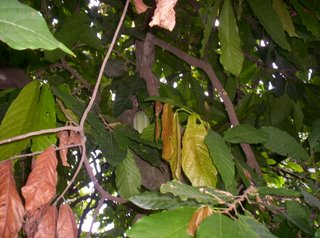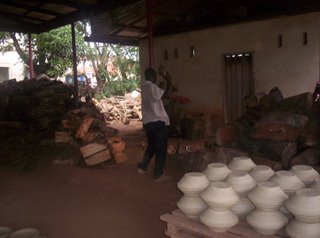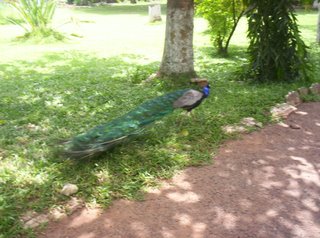Culture of Kumasi
 Culture: via the National Cultural Center and the Manhiya Palace
Culture: via the National Cultural Center and the Manhiya Palace Awal arranged a driver for me, David. When we got to the Cultural Center we stopped at the tourist's station. Then off to the museum. The guide at the museum was very informative.
National Cultural Museum
The museum was only about 30 x 30 feet but it held a lot of pride and history of the Ashanti (Asantes). Many of the artifacts were used in museums around the world, but then returned to the Ashanti and are now displayed proudly.
- photos of the past Kings and Queen Mothers-this was the first of many times I would be told about the King who was captured by the British, along with the Queen Mother and how they were imprisoned, but now they are back as rulers.
- stools-the kings are known to be sacred and therefore their feet may not touch the ground, hence the stools. When a King dies, the stool is painted (or maybe stained) black and never used again.
- battle robe-the actual robe used when the King went into battle. It has amulets and charms on it to protect him and is made with a strong fabric so he wouldn't be harmed.
- pots-used for water and "now just decoration"
- religious pot-it was given by a holy man to the Ashanti Kingdom. They were informed that if they ever opened the pot, it would be the demise of their kingdom. Needless to say, it has never been opened.
- royalty masks-when royalty died, a mold was made of their face and put on their grave.
- funeral pots- when the king dies, his fingers, toes, and head are cut off and put in funeral pots; then they are buried with the king.
- bangles-put on children to protect them, metal (I would guess copper maybe brass, maybe they are the same, I am not sure).
- women were never kings because they menstruate, and therefore, they are unclean.
- security system-they put a staff with a special design on it and when they are not home they would put that in front of the door to indicate it is locked, if someone enters then they are executed.
- Two types of textiles:
- Adinkra. It means good-bye, so maybe people thought it should only be worn at funerals, they have since changed that. Adinkra is a print painted on fabric. The symbols used mean something: for example, democracy/unity, humility/strength, and beauty/cleanliness.

- Kente. Weaving of designs into fabric. The women wear 3 pieces, while the men only have one long piece. ( I am wearing Kente in this picture)
- Clans- There are 8 major clans in the Ashanti kingdom. Each clan represents social class and many times jobs. There are the parrot, buffalo, dog, eagle (king's), leopard, bat, crow, and vulture.
- A staff with a child touching a tiger-means ignorance is a disease.
- Drums-4 types: war, funeral, royal, and dance. The drum used in war was pounded and also when they ran out of ammunition they turned the drum stick around and scratched the drum. When the guide did this, it made a sound like a lion growling.
The Ashanti are very proud people. In addition, they are proud of the cultural center they built a long time ago to preserve their history and culture. When you walk around the center, there are craftsmen creating and selling their goods. I took notes and bought a few things.
- Kente Weaving-done by hand, but also use large looms. Traditionally, men were the only weavers, because if a woman was pregnant, the loom couldn't fit at her belly. They weave 20-40 yards and it takes two weeks to set up the loom. Notice, if you can, it is a man weaving this cloth. This is very different from Indonesia, where men are strictly forbidden to weave. Many of the Kente designs are from certain areas, clans, or artists.

- Pottery-they gather the cement/clay and turn the wheel by hand. Then, put it in the large kiln to bake. This is a man chopping wood by the kiln.

- Gold Weights- used as currency, the gold was made into different shapes using bees wax,
 palm oil, fire and then brass. I bought three brass/copper bracelets from this shop. Does anyone know why? Yes, because the first slaves traded to Europeans were traded for three copper/brass bracelets by the King of Benin to the Portuguese. This man is mixing the charcoal and cement used for the mold.
palm oil, fire and then brass. I bought three brass/copper bracelets from this shop. Does anyone know why? Yes, because the first slaves traded to Europeans were traded for three copper/brass bracelets by the King of Benin to the Portuguese. This man is mixing the charcoal and cement used for the mold.
- Traditional Village
- Cacao trees-they produce a bean like pod that is used for chocolate
- If one gets lost in the forest, all you have to do is look for this structure made with trees and you will know that there is civilization nearby.
- Pour libations- to pray for a good harvest, the people would pour some of their drink on the ground as an offering.
- toilets-men's and women's on the opposite side of the village. It is a structure with a big hole and boards across. Up to 4 people can be in there at the same time.
- tree of god-the tree is where the entertainment is at night, the men are allowed to drink palm wine. It is called god's tree because a water pot is put in the branches to catch the rain water.
- The rooms are in a circular model around a center common area.
Market-largest public market in Ghana- people from Mali, Burkina Faso, Benin, and Cote D'Ivoiry (Ivory Coast) congregate there to buy and sell goods.

There were stalls all over, and on the perimeter there was a train track. The merchants set up shop here too. When the train comes, it blows it horns to warn the people to get off the tracks. Not on the list of job locations I would work.
Manhiya PalaceAwal had told me the Ashanti enjoy beauty. Around the palace, peacocks were roaming, when I commented I was told, "Well, they are beautiful birds." The palace wasn't that large, it was kind
 of like a very large house with wax figures of past kings and queens. The British built it for the King, but he refused to move in until the Ashanti had paid every cent of what it cost back to the British. In a room that was a past king's office, they showed us a pen that he wrote with when he was not with his seven wives. It was about a foot and a half long...okay maybe that's an exaggeration, but truly it was bigger that would be comfortable to write with. The queen mother was impressive to me. She led the Ashanti into battle against the British saying "ghost widows will get husbands." eloquent woman.
of like a very large house with wax figures of past kings and queens. The British built it for the King, but he refused to move in until the Ashanti had paid every cent of what it cost back to the British. In a room that was a past king's office, they showed us a pen that he wrote with when he was not with his seven wives. It was about a foot and a half long...okay maybe that's an exaggeration, but truly it was bigger that would be comfortable to write with. The queen mother was impressive to me. She led the Ashanti into battle against the British saying "ghost widows will get husbands." eloquent woman.
0 Comments:
Post a Comment
<< Home